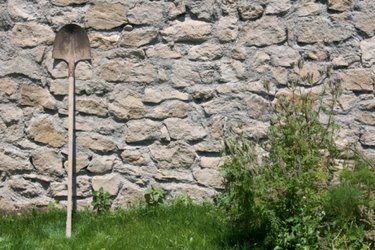Things You'll Need
Lawn mower
Lopping shears
Glyphosate herbicide

That weed in your garden that looks like bamboo is very likely Japanese knotweed. Sometimes called Mexican bamboo, Japanese knotweed grows vertically on segmented stalks like bamboo and can also grow very tall--over 10 feet in some cases. But unlike most species of bamboo, Japanese knotweed is an aggressively growing, invasive plant. Its underground rhizomes grow rapidly, regenerate easily and store the energy that enables this pest to pop up again and again. Whether you use physical or chemical control methods, it will take several seasons to eradicate this bamboo look-alike.
Step 1
Cut the existing stalks down to ground level with a lawn mower (for young plants) or pair of lopping shears.
Video of the Day
Step 2
Dig up the roots and pull them out. The key to Japanese knotweed's success lies in its tenacious rhizomes, or roots. Pull up as many of these roots as you can. They can spread meters deep and wide, and even a small piece left behind can grow a new plant. Pull up all of the rhizomes that you can see in the top foot or so of the soil.
Step 3
Kill any Japanese knotweed shoots that re-grow. Mowing them or cutting them to ground level with a pair of pruning shears is one option. Or, spray them with a glyphosate-based broad spectrum herbicide. This herbicide will kill any plant that it comes into contact with. Follow the manufacturer's instructions and use it with care. No matter what method you choose, be sure to cut the Japanese knotweed before it reaches 4 inches in height. This will prevent it from storing more growing energy in its rhizomes.
Step 4
Dig up the root bed again in 4 to 6 months, following the instructions in Step 2. Continue digging up the root bed once every four to six months and killing new growth in between until the Japanese knotweed no longer comes back.
Step 5
Re-plant the area. By introducing a competitive ground cover or plant that grows well in the area, you can significantly reduce the likelihood that Japanese knotweed will come back.
Video of the Day